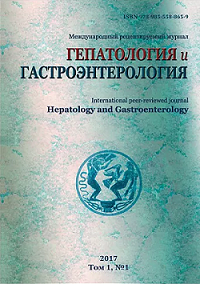PROOXIDANT-ANTIOXIDANT BALANCE IN LIVER OF RATS AFTER ADMINISTRATION OF IMMUNOSUPRESSANT MYCOPHENOLATE MOFETIL
Abstract
Background. The growth of immunodeficiency, unclearness of pathogenesis necessitates the reproduction of experimental immunosuppression in laboratory animals.
Objective. To study the prooxidant-antioxidant equilibrium in rat liver after the administration of immunosuppressant mycophenolate mofetil (MMF).
Materials and methods. The activity of free radical processes in liver tissue was assessed by the content of lipid peroxidation products: diene (DC) and triene (TC) conjugates, malonic dialdehyde (MDA). The content of nonenzymatic and enzymatic AOC components was assessed by the level of α-tocopherol, retinol, reduced glutathione (GSH), ubiquinone (CoQ) and catalase activity.
Results. The administration of the MMF at a dose of 40 mg/kg daily for 7 days does not result in the accumulation of products of lipid peroxidation in the sample of liver tissue, which may be due to the active use of the lipophilic antioxidant components of the cell. In 7 days after discontinuation of the administration of the drug, complete restoration of prooxidant-antioxidant balance in liver is observed in animals. A two-week injection of MMF at a dose of 40 mg/kg daily results in the activation of the peroxidation of lipids in liver tissue that can lead to subsequent death of the hepatocyte underlying the drug-induced liver injury (DILI).
Conclusion. Intragastric administration of the MMF for 7 days at a daily dose of 40 mg/kg can be used for experimental modeling of immunodeficiency without development of signs of toxic damage to the liver by free radical origin, which occurs in the case of classical immunosuppressants.
References
1. Andreev, A. Ju. Metabolizm aktivnyh form kisloroda v mitohondrijah [Metabolism of reactive oxygen species in mitochondria] / A. Ju. Andreev, Ju. E. Kushnareva, A. A. Starkov // Biohimija. – 2005. – T. 70, № 2. – S. 246-264. (Russian)
2. Borovikov, V. P. Statistica. Iskusstvo analiza dannyh na komp'jutere / V. P. Borovikov. – Sankt-Peterburg : Piter, 2003. – 688 c. (Russian)
3. Dubinina, E. E. Produkty metabolizma kisloroda v funkcional'noj aktivnosti kletok (zhizn' i smert', sozidanie i razrushenie). Fiziologicheskie i kliniko-biohimicheskie aspekty / E. E. Dubinina. – Sankt-Peterburg : Izdatelstvo Medicinskaja Pressa, 2006. – 400 s. (Russian)
4. Kamyshnikov, V. S. Spravochnik po kliniko-biohimicheskoj laboratornoj diagnostike : v 2 t. / V. S. Kamyshnikov. – 2-e izd. – Minsk : Belarus, 2002. – T. 1. – 465 s. (Russian)
5. Karbociklicheskie analogi inozin-5'-monofosfata: sintez i biologicheskaja aktivnost' / E. S. Matjugina [i dr.] // Actanaturae. – 2012. – T. 15, № 4. – S. 75-79. (Russian)
6. Skulachev, V. P. Javlenija zaprogrammirovannoj smerti. Mitohondrii, kletki i organy: rol' aktivnyh form kisloroda [The phenomena of a programmed death. Mitochondria, cells and organs: the role of reactive oxygen species] / V. P. Skulachev // Sorosovskij obrazovatel'nyj zhurnal. – 2001. – T. 7, № 6. – S. 4-10. (Russian)
7. Sopostavlenie razlichnyh podhodov k opredeleniju produktov POL v geptan – izopropanol'nyh jekstraktah krovi [Comparison of different approaches to the determination of LPO products in heptane-isopropanol extracts of blood] / I. A. Volchegorskij [i dr.] // Voprosy medicinskoj himii. – 1989. – T. 35, № 1. – S. 127-131. (Russian)
8. Chirkin, A. A. Molekuljarnye mehanizmy povrezhdenija pecheni [Molecular mechanisms of liver damage] / A. A. Chirkin // Immunopatologija, allergologija, infektologija. – 2000. – № 1. – S. 26-33. (Russian)
9. Aruoma, O. I. Antioxidant Methodology: in vivo and in vitro Concepts / O. I. Aruoma, S. L. Cuppett. – New-York, 1997. – 241 р.
10. Bartosz, G. Drugatwarztlenu / G. Bartosz. – Warszawa : Wydawnictwo naukowe PWN, 2003. – 447 р.
11. Björnsson, E. S. Hepatotoxicity by Drugs: The Most Common Implicated Agents / E. S. Björnsson // Int. J. Mol. Sci. – 2016. – Vol. 17, № 2. – P. 1-7.
12. Chong-Han, K. Dietary lipophilic antioxidants: implications and significance in the aging process / K. Chong-Han // Crit. Rev. Food. Sci. Nutr. – 2010. – Vol. 50, №. 10. – P. 931-937.
13. Dey, A. Alcohol and oxidative liver injury / A. Dey, A. I. Cederbaum // Hepatology. – 2006. – Vol. 43, № 2. – P. 63-74.
14. Effects of vitamin A deficiency on mitochondrial function in rat liver and heart / E. Estornell [et al.] // Br. J. Nutr. – 2000. – Vol. 84, № 6. – P. 927-934.
15. Mycophenolate mofetil significantly reduces leukocyte graft infiltration after heterotopic cardiac transplantation in a rat model: comparative study with cyclosporine and FK 506 / M. H. Richter [et al.] // J. Heart Lung Transplant. – 2003. – Vol. 22, № 10. – P. 1107-1116.
16. Olejarz, W. Mycophenolate mofetil – a new atheropreventive drug? / W. Olejarz, D. Bryk, D. Zapolska-Downar // Acta Pol. Pharm. – 2014. – Vol. 71, № 3. – Р. 353-361.
17. Sedlak, J. Estimation of total, protein-bound, and protein sulfhydryl groups in tissue with Ellman’s reagent / J. Sedlak, R. N. Lindsay // Anal. Biochem. – 1968. – Vol. 25, № 1. – P. 192-205.
18. Stine, J. G. Chronic liver injury induced by drugs: a systematic review /J. G. Stine, N. Chalasani // Liver Int. – 2015. – Vol. 35, № 11. – P. 2343-2353.
19. Taylor, S. L. Sensitive fluorometric method for tissue tocopherol analysis / S. L. Taylor, M. P. Lamden, A. L. Tappel // Lipids. – 1976. – Vol. 11, № 7. – P. 530-538.
20. The Effect of Mycophenolate Mofetil on Early Wound Healing in a Rodent Model / M. C. Willems [et al.] // Transplant. Direct. – 2016 – Vol. 20, № 6. – P. e80.
21. Wiesner, R. H. Present state of immunosuppressive therapy in liver transplant recipients / R. H. Wiesner, J. J. Fung // Liver Transpl. – 2011. – Vol. 17, Suppl. 3. – P. S1-S9.


















1.png)






